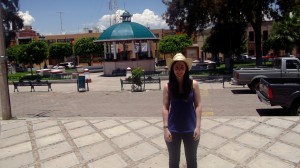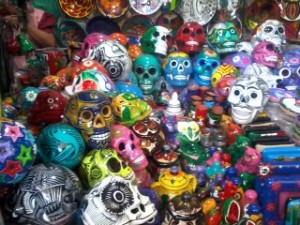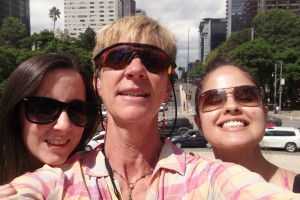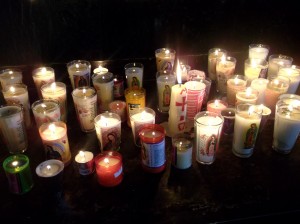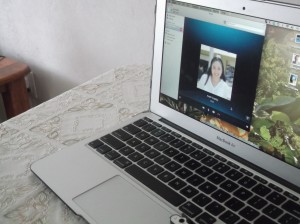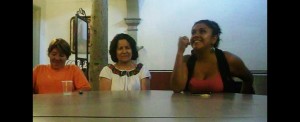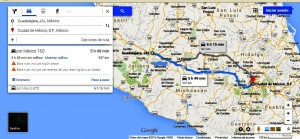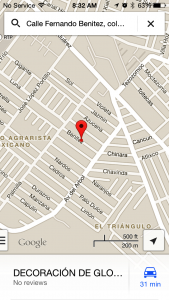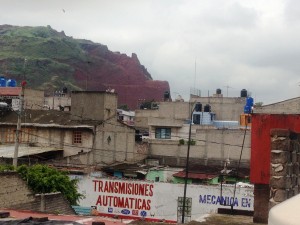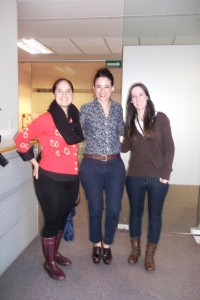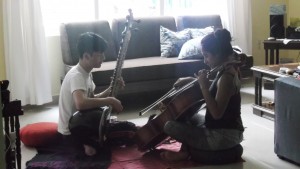Archive for category Ainhoa Martinez
See you soon Mexico
Posted by Ainhoa Martinez in Ainhoa Martinez, Mexico on August 10, 2014
Today is my last day in the field and I am packing everything and getting ready to come back home after 2 months of great moments in this wonderful country.
It is a mixture of feelings what I feel about Mexico. I hate it and love it at the same time. The main reasons to hate it are security issues and the situation of women. However, after travelling to different countries one get used to deal with this problems: be home before it gets dark, don’t go to dangerous areas in the city, control the time when you move around the city, you can feel safe as long as you see women and kids around you, don’t wear anything flamboyant, if somebody bothers you don’t start a fight (just avoid that person and try to leave the situation in th better way you can)… The situation of women is complicated, there is a lot of “machismo”, but at the same time you can find the most polite people in the word. I have been lucky to find always the right people and had no problem.
Travelling by bus around the country has been pretty nice. Companies usually offer good prices for students and the buses were very comfortable. At the beginning I wasn’t sure this was going to be like this. I mean, everyone knows about the insecurity problems of this country, but it was okay. You just have to keep an eye on the time you get the bus and the time you arrive to your destination (preferably during the day).
Leaving this apart, I want to focus on the good things I hve been able to see and live. Mexico has very bad reputation, but it is like any other country You will be safe as long as you don’t get in troubles. Also, you can have a different view from this country depending on where you are living. When I go abroad, I always try to live in the student area of the city, close to universities. Because you will always find a good atmosphere there, with transportation and other services. And it is also a good way of living the real life of the country. For example, here there is a world between the live in the center and univerity area (although Coyoacan area is wonderful). And I don’t need to tell you if we compare it with other marginal places in the city, you can imagine. Some friends of mine had been working in Mexico City in the past and living in other areas, but we have very different opinions about this country. Mine is good.
Out of Mexico things always are focused in drugs and kidnapings. What is a reallity that I won’t deny, but it makes us blind and doesn’t let us see how rich and wonderful this country is:
THE FOOD: Mexican food is my favorite one from now onwards. And what I like most is that I have been able to learn how to cook it. Cheap, delicious and 100% natural food, with no additives. In fact, I have been eating properly and doing some execise during the fellowship and now I feel much more healthier. And another good thing is that I finally got used to spicy!
THE NATURAL ENVIRONMENT: Mexico and Latin America in general are the lungs of the world. I have read about it in the past, but being able to watch those amazing natural spaces with my eyes has been delightful. However, when we visited El Salto (Jalisco) and Tlaxcala to see how industries threw toxic substances into the rivers, it was disgusting. I want to mention one of the most hurtful truths Enrique (from “Un Salto de Vida” organization) told me when we were in El Salto: “Nature does not charge interest to companies”.
THE PEOPLE: before comming here I was told “although you find people so so kind, do not trust anybody at all”. I think that suggestion could be applied to every trip around the world and I have been cautious with the people I met and the information I shared. But what I have found here is extremely polite people, in any context. That’s why it’s crazy to see that at the same time you know how women situation is here. Anyway, it’s a place full of contrasts. I don’t know in the US, but unfortunately in Spain Mexican people have bad reputation for being lazy people. I want to take this opportunity to say it is a huge and false prejudice. Mexican people are the most hard-working people I have ever seen. Waking up at 4 am to work endless hours, earn too low wages and come back home to take after your family. Whoever thinks mexicans are lazy people is deeply wrong.
THE CULTURAL ENVIRONMENT: I feel I have addapted well to living here because Mexican culture has a lot of influence from the Spanish. Some places I have visited reminded me of Spain. For example, Guadalajara was very similar to Zaragoza (a city in Spain). Apart from the similarities, I love Mexico City because it is easy to find any cultural activity. There is so much live in the place! Theatres, book markets in the streets, free concerts, choirs, people playing music in the streets, orchestras, art galleries, museums … My favourite ones were Rivera paintings and the Antropology Museum. You cannot leave Mexico City without visiting them.
THE ARTS AND CRAFTS: walking throught the street “mercados” was really nice. You could talk to local people and watch all kind of handmade crafts. I am bringing with me some of them to Spain, but if I could I would have bought everything there, hehe, it was beautiful.
I hope next year the fellowship continues and other fellows are sent to Mexico again. I will be happy to talk to them and give a lot of suggestions.
I want to show you some pics from our best moments here:

This is the “mercado” in the center f Coyoacan. Our favourite place to eat and have a big orange juice.
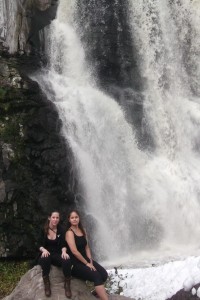
We are at the bottom of “El Ahogado” waterfall, in El Salto (Jalisco). You can see toxic substances on the right part of the picture. The strong smell was horrible.
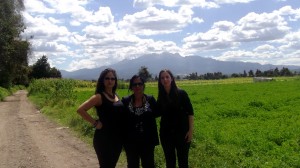
In Tlaxcala, when we went to visit River Xochiac, a red river because of companies’ toxic substances. The mountain behind us is the Iztaccihuatl volcano.
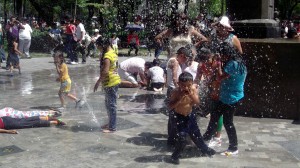
This is my favorite moment. We found a lot of families in a park during a warm weekend day. Kids were playing in the fountains. I wanted to jump in. I have named it “the joy of water”.
In a few hours I will be taking my flight back home. I hope I am able to meet all of you in november at Monterey, I’m sure we have a lot to talk about. I was already aware of environmental issues and water conflicts, but this experience has helped me to understand better the problem and go beyond the books. Being able to make visible these water problems and help such nice people has been truly enriching.
I want to thank Amy and Jessica for being such wonderful mates and Dr. Iyer for her suggestions and her talk about trusting ourselves and our work. I really feel we all are peacebuilders.
I still have some good stories to share, but next time I will be sharing them with you from Spain.
See you soon Mexico. I will come back.
Last days in Mexico City
Posted by Ainhoa Martinez in Ainhoa Martinez, Mexico on August 9, 2014
As the fellowship on water conflicts is comming to an end, this week I have visited some places I haven’t been to and came back to my favorite sites of the city one last time.
First I visited “La Villa – Basílica de Guadalupe”, where the virgin of Guadalupe is placed. I told you in my first blog I didn’t want to leave Mexico without visiting this place and pray for my family. So I did.

The virgin of Guadalupe is where you see the light in the center. I thought the image would be bigger.
My favorite places in the city are “Viveros de Coyoacan” and the center of Coyoacan, so today I took my mp3 and went to take my morning walk through Viveros park, which ended at 3 pm. I was enjoying it so much and didn’t want to leave.
Women worthy of admiration
Posted by Ainhoa Martinez in Ainhoa Martinez, Mexico on August 7, 2014
The power of women gets stronger when we join our forces and I have been able to check it during my experience in Mexico.
In all the cases of water conflicts we found in Mexico, there were women fighting against injustice, threats, working to bring water to their homes, standing in the first row in every marching to defend their right to water.
I want to express my admiration for them through this blog. Because it is not only the social or administrative fight they stand up against, it is also a huge psychological and internal fight the one they struggle. Having to deal with severe threats (in first person and to their family members), police reprisals, suffering health problems and watching how people surrounding them are dying of illnesses caused by water pollution … All these struggles are difficult to deal with in your life and watching this women standing up against all and continuin their everyday life really inspires me. They are such strong people.
That’s why I wanted to send them a huge THANK YOU.
Thank you for inspiring me.
Thank you for receiving and welcome us as if we were a member of your family.
Thank you for sharing with us your struggles, worries and thoughts.
Thank you for not loosing your smile.
Thank you for being such brave women.
And thank you for being who you are, real people with real problems and a huge heart.

The lovely Graciela, a biologist, who looks after her family at the same time she works against injustice, threats and the pollution in Santiago River (El Salto, Jalisco). She has got a strong heart.
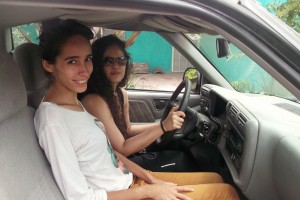
Sofia, Graciela’s daughter. Also working in the same issues as her mother does and helping in a research on food conflicts. She is such a brave young woman.

Mother Lupita and Ale from “Centro Fray Julian de Garces, Derechos Humanos y Desarrollo A.C.” in Tlaxcala. Their most important working issues are water pollution and women rights. They provide education to communities to promote human rights.
De todo corazón este blog está dedicado a ustedes, las mujeres mexicanas.
Jalisco, I love you
Posted by Ainhoa Martinez in Ainhoa Martinez, Mexico on July 23, 2014
Nature is life and water is life. That can perfectly summarize our trip to Jalisco this past week. It was a long journey by bus, but it was worth it. Within this trip I have seen myself as a real researcher and listening to all the stories individuals told us made me feel for the first time in my life like a peacebuilder, a real and a helpful peacebuilder.
Our journey started with a 7 hour bus travel from DF to Guadalajara. We spent our first 3 days in El Salto, gathering a hard water conflict story involving threats, health problems and water pollution in River Santiago.
Then We spent a day in Guadalajara talking to people from Temacapulin, wich is a small village where government and companies want to build a huge water dam, which in fact would destroy their homes and community because the village is located exactly where the dam is thought to be built.
Early in the morning, we took another bus to get to Villaguerrero, Jessica’s father’s and family’s hometown. I really fell in love with this village. In fact, I have one new dream in my life: I am going to safe 150,000 euro, buy a 3000 square metres Rancho, a house and a horse in Villaguerrero. hehehe. All of you will be welcome to try tequila and walk through the magnificient lands and mountains surrounding the area. When we walk through the Rancho I could not avoid thinking of Amy and the stories she had told me about Colorado, she would have loved this place, I wished she had come with us.
This picture I took in the Rancho perfectly illustrates my feelings of peace and happiness there:
Jessica and I will be writing more details about our experience in Jalisco. I can say it has been an amazing trip, which has given me a new way of understanding people and a different view from the world surrounding us.
Jalisco, I love you and I promise I will come back.
Trying to keep fit and healthy
Posted by Ainhoa Martinez in Ainhoa Martinez, Mexico on July 15, 2014
Since I started Law School I knew I wanted to dedicate my career to travel and work in developing countries. Apart from your professional or academic skills, I believe keeping your mind and body strong is a key fact to perform a successful mission. This thought came to my mind again when I got sick because of the altitude and had to go to the hospital. I felt pretty weak for some days, but then, decided to put an end to it. 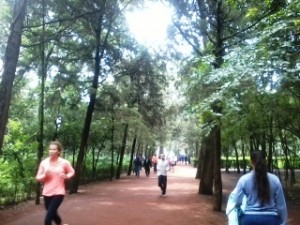
That’s why I dediced to start doing some exercise in the mornings. These last weeks I have joined Amy and Jessica in our morning walk + healthy breakfast around Viveros de Coyoacan, one of the lungs of the city.
It is amazing how your body and mind get full of energy after a walk through the park. You can see people who are totally strangers getting together to form a group and do different kind of exercises. Childs, youngsters, elderly people … Everyone gets their piece of nature here. In fact, if you go on the weekend you will almost have to queue for a walk as it is crowded.
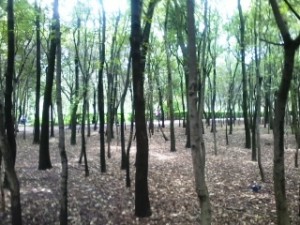 Viveros is a great opportunity to escape from the smokes and extreme pollution of the city. I really feel I can breathe fresh and clean air when I get there. Also, it is a good place to keep your mind in peace. I mean, sometimes we have to deal with uncomfortable security situations, watch real poverty just next to the richest ones, feel how women are not properly respected in some cases and, of course, be aware of corruption issues in the country. It is important to stop and take a breath once in a while.
Viveros is a great opportunity to escape from the smokes and extreme pollution of the city. I really feel I can breathe fresh and clean air when I get there. Also, it is a good place to keep your mind in peace. I mean, sometimes we have to deal with uncomfortable security situations, watch real poverty just next to the richest ones, feel how women are not properly respected in some cases and, of course, be aware of corruption issues in the country. It is important to stop and take a breath once in a while.
Iztapalapa, the district hit by water conflicts.
Posted by Ainhoa Martinez in Ainhoa Martinez, Mexico on July 7, 2014
Our second individual interview took place this weekend, in the Delegation of Iztapalapa where we got a glimpse of water issues affecting an entire district.
This district lies in the northwest region of the city. An area high in crime, low resources and known to be overpopulated. Taking these facts into account, we decided to get to the district on Sunday because it’s a sort of family day, in which you can see streets full of parents with their children and local markets.
Getting to Iztapalapa was an adventure: the metro line we thought we could take all the way down to our destination was blocked off halfway. From what we were told, glitches in the line had made the rest of the line unsafe to travel. We took stairs back up to the street where a free bus line stopped at every closed metro station. After that we took a small van crammed with locals deep into the heart of Iztapalapa.
We couldn’t avoid thinking of Phoenix’s blog post about travelling in small buses in Ethiopia. The situation was funny and a little bit concerning, as we weren’t sure how safe the vehicle was. Fortunately, having women and kids around made us feel safe (this feeling has come to us in more than one ocassion). Over bumps and zig-zagging our way through what seemed like a maze, the van got us quickly to our destination.
We felt grateful that our interviewee opened her home to us with open arms. We explained the project once again and asked if we could videotape her story, “anything to help bring attention to this,” she replied, nodding in agreement. She gave us the history of her family and it’s issues with water scarcity and contamination. With a bright eyed, joyful demeanor she began to weave a story that started decades ago, when there were no water problems at home.
We were amazed to find how a little bit of clean water can be used time and again for different household chores. It made us conscious of how much water we use daily without once thinking about how we might recycle it. Water used for showering, to flush the toilet. Water used for washing clothes to mop floors. In this case we learned that need leads people to be creative in finding solutions to survive.
We left the house with the feeling of a job well done, and the hope that our project brings a voice to these problems. If we can help this family by telling their story we will have done our job.
On our way back home, almost by chance, we found multiple “Pipas” (trucks used to distribute water to individual houses). We quickly took our cameras out and took photos for about 20 seconds, until we saw a guard approaching us and we quickly left.
Weeks before, a policeman started asking questions about “what we were doing” when on Insurgentes taking a photo of a road that was flooding. “It’s for the photo memory album, we are from a small village and have never seen so much traffic in the street,” we lied. Then the policeman started talking about the World Cup and we quickly slid away. So this time in Iztapalapa, we didn’t want to try our luck!
The altitude of Mexico City
Posted by Ainhoa Martinez in Ainhoa Martinez, Mexico on July 2, 2014
These last days I have been feeling a little bit sick because of the lack of oxigen in the air and the altitude at which is located Mexico City. After calling my insurance service and visiting the doctor, I am feeling much more better now that I have taken the proper medicines.
The problem is that I usually live in a city located at the sea level and Mexico City is about 2,300 meters (7,500 ft) above that level. The higher the city is located, the less pressure is in the atmosphere. Because of that, there is less oxigen in the air and each person reacts in a different way. For example Amy came from Colorado, which is located in a higher altitude from the sea level than Mexico City, so she is doing well.

Mexico City is located in the Valley of Mexico, in the central-southern area of the country. In addition, there are 2 volcanos close to the city.
But what is most characteristic of this area is the fact that inside the city you can go from zero level (sea level) to the highest:

In this map you can see the different “Delegaciones” of Mexico city and their altitude above the sea level. “Delegaciones” are the different districts among the city.
And I wouldn’t be telling you all these facts if it had nothing to do with water conflicts. The altitude of the whole city and the different altitudes where the “Delegaciones” are located do affect the water problems of the city. It is all about water pressure. If the “Delegación” is located in a medium level where water reaches without the need of machinery, you will probably have no problem with water supply. However, if it is located in a higher level machinery will have to push it to the top, which generates a huge cost and does not always work properly.
For example, Jessica, Amy and I are living in “Delegación Coyoacán”. Inside Coyoacán there are different levels and as a result of that, you can find great water conflicts or the best water supply at the same time in the same area. If you had read Jessica’s last post on the blog, you will note she’s been having some problems with water at home, whereas I have no water supply problems at home because there is a lot of pressure in the water that enables it to reach homes.
Last day we were visiting the craft market of Coyoacán and had the opportunity to talk to the people working there.  We met Mrs. Mónica Robles there, a woman who was selling incense, natural products and tiny zen gardens at her market stall and who, for our surprise, was majored in Antropology. She told us people living in “Colonia El Rosedal” (a neighborhood just next to us in Coyoacán) were having some water problems.
We met Mrs. Mónica Robles there, a woman who was selling incense, natural products and tiny zen gardens at her market stall and who, for our surprise, was majored in Antropology. She told us people living in “Colonia El Rosedal” (a neighborhood just next to us in Coyoacán) were having some water problems.
We will plan to gather stories in El Rosedal area for the next week. Meanwhile, the Doctor told me to stay in bed and take my medicines for the next 3 days and Jessica and Amy are also looking after me (thanks Constructoras de paz!). I will be totally recovered for the weekend, when Jessica and I are visiting a house where the family members are suffering from water supply and sanitation problems. I cannot wait to see what we find there!
Our first water story after an exhausting day
Posted by Ainhoa Martinez in Ainhoa Martinez, Authors, Mexico on June 27, 2014
June 25th, we had a meeting with Mrs. Mara Hernandez (a specialist on water conflicts in Mexico).

Jessica and I spent half of the morning wondering around Insurgentes. It seemed like it had no end as it crosses the whole city from North to South.
Jessica and I felt a little bit lost among Insurgentes main avenue, Mrs. Hernandez was vague in giving us specifications about how to find her office, we might had the wrong address and Amy was in the city too, so we had to guide her in order to locate us among the huge avenue.
Surprisingly, Amy found the office and us in her first try to walk among the city alone. She is such an experienced woman with great skills and
I was impressed because I would not have been able to locate myself during my first day in the city without Jessica’s help. We were so happy to find her and got ready for our meeting.
The meeting went great and it was truly worth it. Mara helped us clarifying what kind of water problems are suffering people living in Mexico, she gave us different views about the conflict and provided us with some contacts which I am sure will be useful for us.
It was a wonderful coincidence that a woman working at Mrs. Hernandez’s office suffered from some water supply and shortages issues at her home and she felt comfortable in telling us her story. I felt glad we found our first story, but also concerned about this woman´s reality. Without water there is no life (in any extent, society level or location) and being able to empathize with people directly affected by water conflicts has given me a more human and real perspective out from the one I can take from the books or documentaries.
Coming back home was an adventure for us. We left Amy at the metro and Jessica and I took the metrobus, which is one of the fastest ways of travelling by public transport among Insurgentes avenue. Please check out my “pendeja face” while taking the metrobus, it was crowded and getting out of it could be described as giving birth to a crowd.
The house of musicians
Posted by Ainhoa Martinez in Ainhoa Martinez, Mexico on June 24, 2014
It’s been more than 2 weeks since I landed in Mexico City and every day I discover new qualities of the people who are around me, which actually fascinate me.
The area where I am living is close to the School of Music and because of that, it is easy to come across with musicians or music students. In fact, two of my roommates are studing music: Hugo plays the piano and Carina plays the Cello.
When it rains heavily here, it is almost imposible to work on the field (floods, traffic jams, electric storms…) and some days we just try to gather information and write to contacts from home.
Last day, while I was studying important facts about water conflicts in Mexico I had the opportunity to join Carina and her Sitar player friend in their rehearsal afternoon.
Becoming a professional musician requires countless hours of rehearsals, so that’s what they did: 8 hours of non-stop music. Thank God I liked it, this is not a house for those who don’t like listening to music.
It was a nice afternoon: it was raining outside, Carina prepared her delicious black tea with ginger and cinnamon and lighted some incense.
Music and art cultures are truly rooted in Mexico City and you can find a lot of free daily events in the city center.
This reminds me of when I started playing the guitar, but had to leave it because of the lack of time. I don’t see myself becoming a professional musician, it is just a hobbie. But I hope Carina succed in her field, she is a talented woman and a dreamer. And who knows, maybe in the future I’ll be sitting in an auditorium enjoying one of her concerts.
Please, enjoy this short clip showing their talent:
Sharing a meal with my Mexican friends
Posted by Ainhoa Martinez in Ainhoa Martinez, Mexico on June 19, 2014
Since the very first moment I arrived to my home in Mexico City, I got on well with my rommates and I promised them I would cook Spanish omelette for them one day.
Well, it’s been almost 2 weeks since I landed here and it was time to prepare a nice dinner, so last night I was the chef.
The Spanish omelette is one of the most popular and tasty typical meals in Spain. I have to say I’m good at cooking and although desserts are my speciality, this time I wanted to share what my mum and granny taught me.
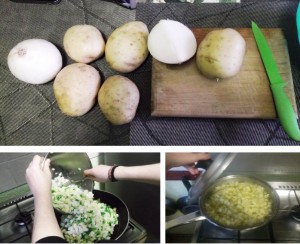
Cut the onions and the potatoes into small squares. Put some salt and fry them in the pan. Then, add some eggs, let it finish cooking and bon apettit.
I like sharing views, traditions and thoughts with people from other cultures. I am lucky I have been able to travel to different countries and have learned a lot from others.
Last night, Carina (one of my rommates) helped me preparing the dinner and we tried to add a Mexican ingredient to the Spanish receipe: the Nopal.
The Nopal is a plant grown in Mexico, with a lot of fiber and it tastes and looks like a pepper (more or less). The Spanish omelette with the Nopal was delicious.
A crucial moment while cooking a Spanish omelette is “the flip movement”. When the eggs are added and one side of the omelette is already cooked, but the other is not, you have to flip it. It can be difficult sometimes, but you can improve with practice.
At the end of the night we enjoyed a nice meal. Hugo and Carina (roommates) also prepared a lemon pie, which was exquisite.
Next time: Mexican spicy food (I hope I can stand the spicy).
